Global Warming: Economic Principles, Models, and Policies Analysis
VerifiedAdded on 2021/05/31
|9
|2012
|33
Report
AI Summary
This report delves into the multifaceted issue of global warming, examining its trends, economic impacts, and the resulting environmental externalities. It explores how rising carbon dioxide emissions and other greenhouse gases affect the global economy, including reduced farm productivity, habitat loss, and rising sea levels. The report analyzes the economic concept of externalities in the context of climate change, highlighting the discrepancy between private and social costs. Furthermore, it assesses various environmental policies designed to mitigate global warming, contrasting market-based approaches, such as environmental taxes and subsidies, with governmental regulations like cap-and-trade programs. A comparative analysis is conducted to determine the effectiveness of each approach, considering factors like emission control, cost to firms, and government intervention, concluding with a recommendation for the most effective strategies.
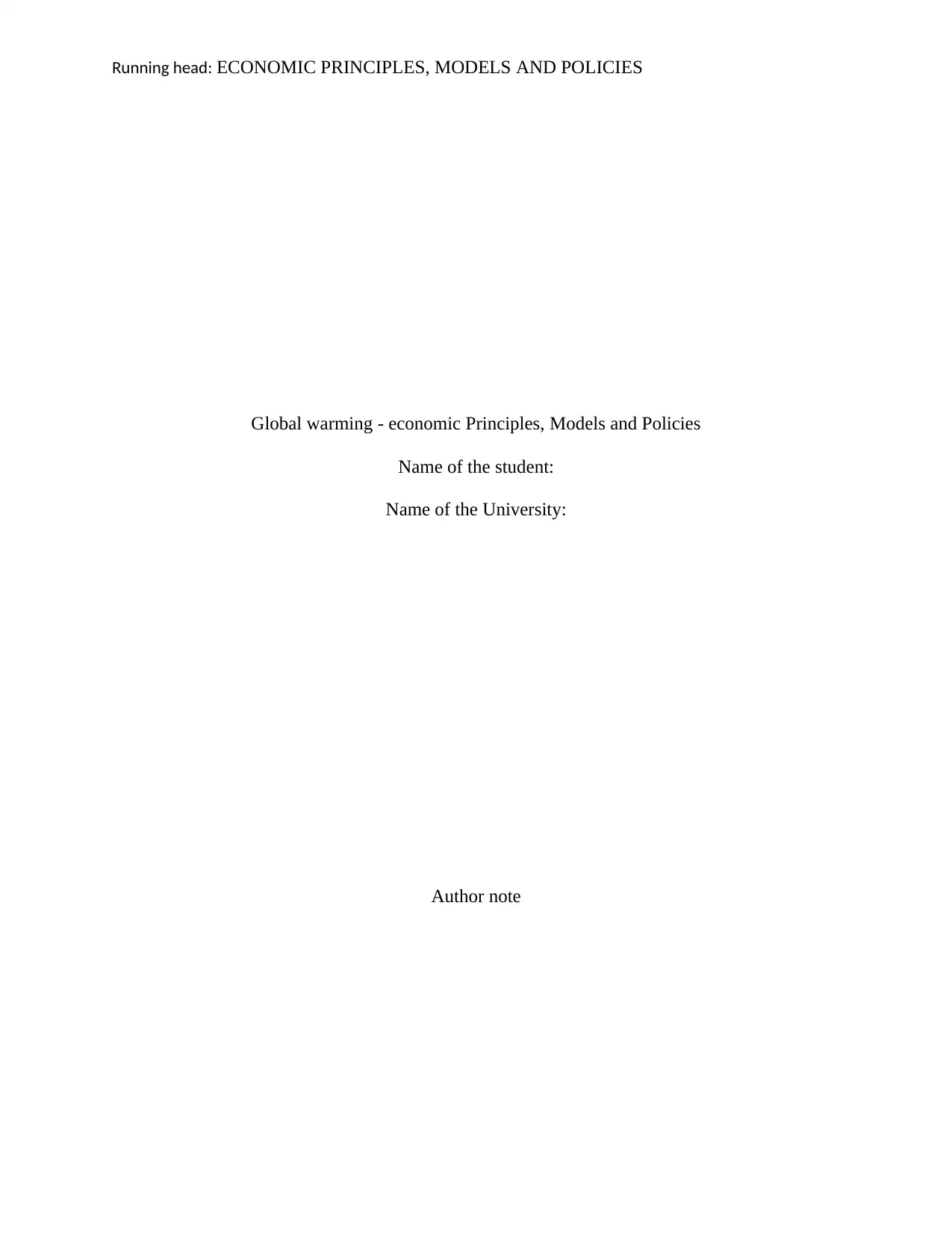
Running head: ECONOMIC PRINCIPLES, MODELS AND POLICIES
Global warming - economic Principles, Models and Policies
Name of the student:
Name of the University:
Author note
Global warming - economic Principles, Models and Policies
Name of the student:
Name of the University:
Author note
Paraphrase This Document
Need a fresh take? Get an instant paraphrase of this document with our AI Paraphraser
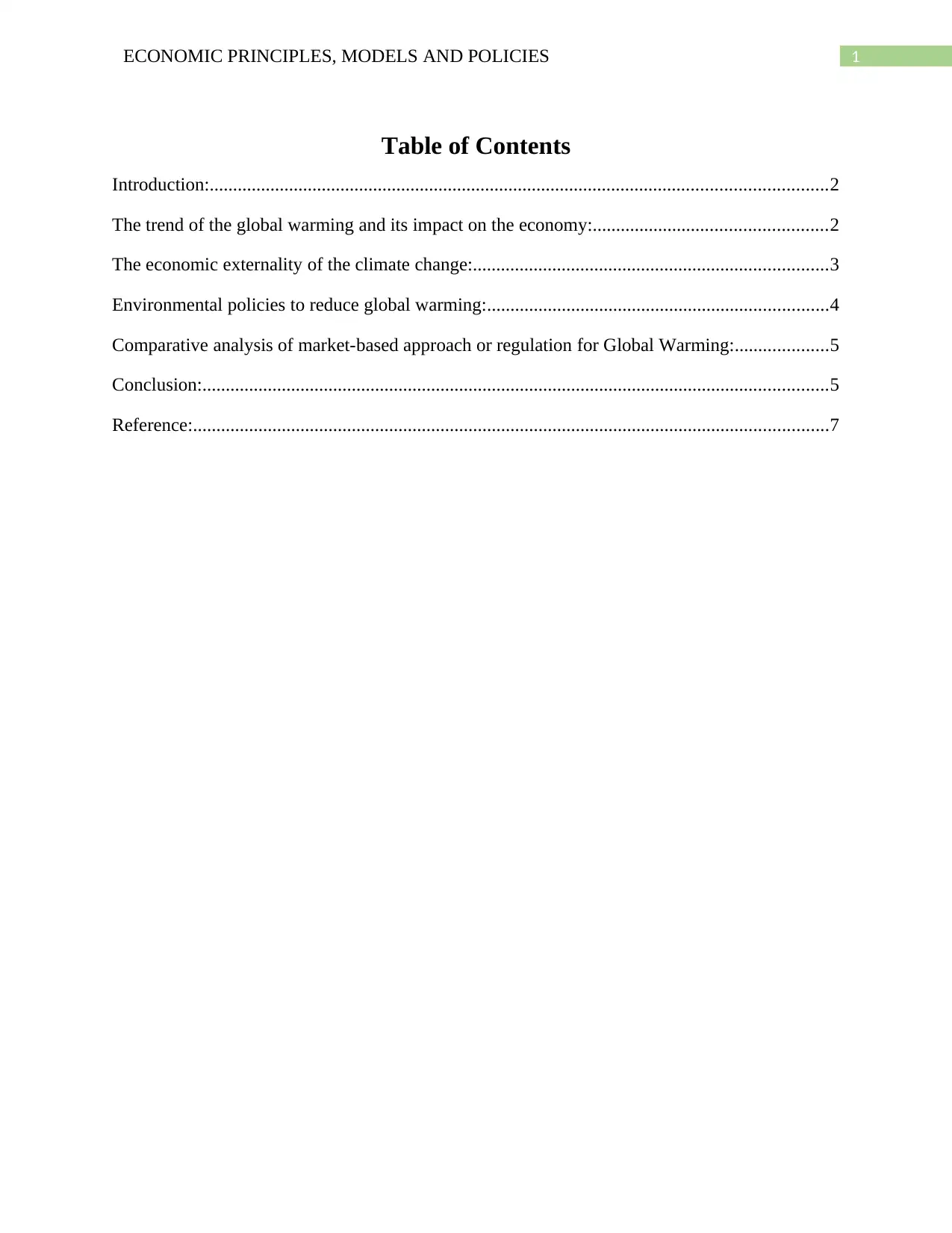
1ECONOMIC PRINCIPLES, MODELS AND POLICIES
Table of Contents
Introduction:....................................................................................................................................2
The trend of the global warming and its impact on the economy:..................................................2
The economic externality of the climate change:............................................................................3
Environmental policies to reduce global warming:.........................................................................4
Comparative analysis of market-based approach or regulation for Global Warming:....................5
Conclusion:......................................................................................................................................5
Reference:........................................................................................................................................7
Table of Contents
Introduction:....................................................................................................................................2
The trend of the global warming and its impact on the economy:..................................................2
The economic externality of the climate change:............................................................................3
Environmental policies to reduce global warming:.........................................................................4
Comparative analysis of market-based approach or regulation for Global Warming:....................5
Conclusion:......................................................................................................................................5
Reference:........................................................................................................................................7
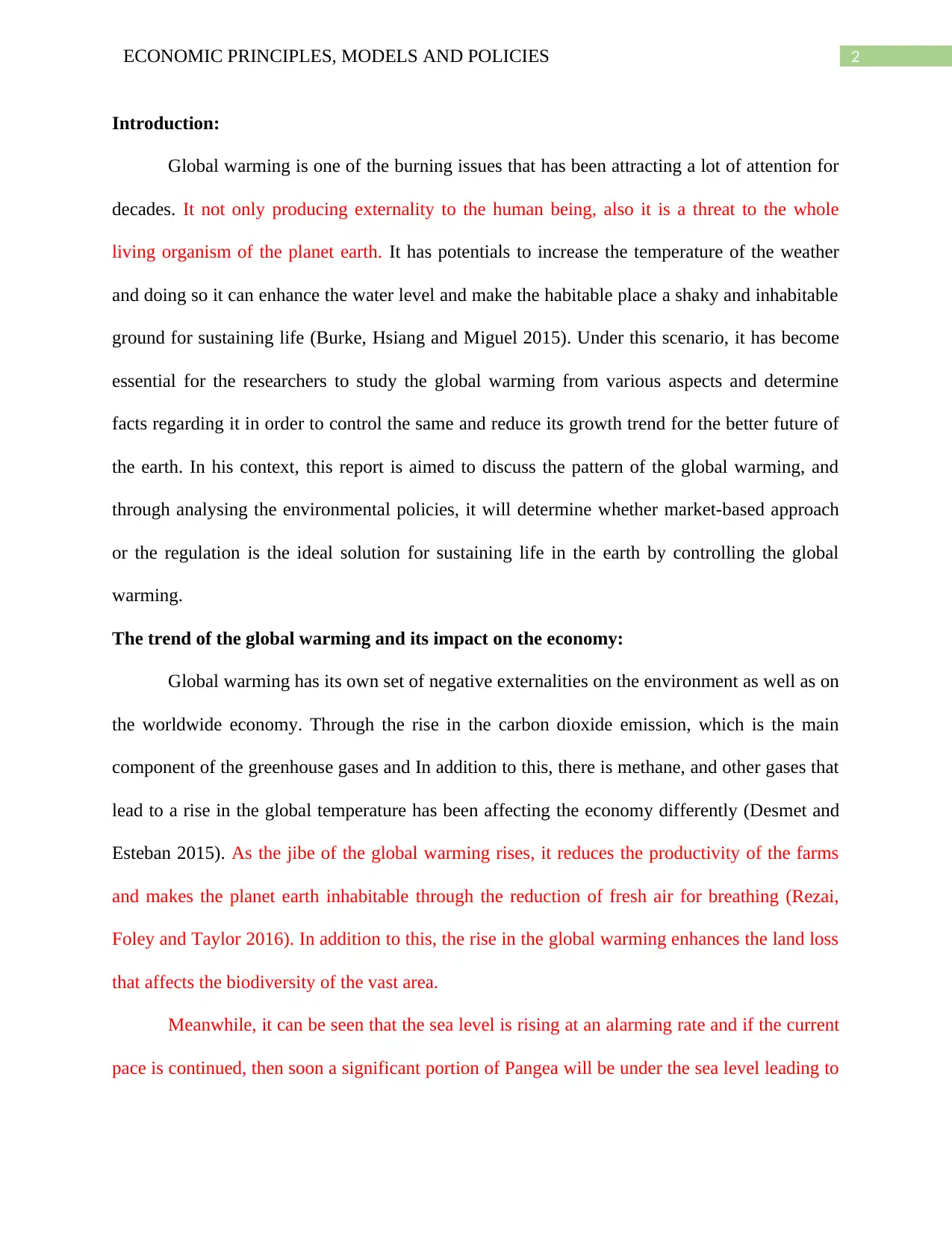
2ECONOMIC PRINCIPLES, MODELS AND POLICIES
Introduction:
Global warming is one of the burning issues that has been attracting a lot of attention for
decades. It not only producing externality to the human being, also it is a threat to the whole
living organism of the planet earth. It has potentials to increase the temperature of the weather
and doing so it can enhance the water level and make the habitable place a shaky and inhabitable
ground for sustaining life (Burke, Hsiang and Miguel 2015). Under this scenario, it has become
essential for the researchers to study the global warming from various aspects and determine
facts regarding it in order to control the same and reduce its growth trend for the better future of
the earth. In his context, this report is aimed to discuss the pattern of the global warming, and
through analysing the environmental policies, it will determine whether market-based approach
or the regulation is the ideal solution for sustaining life in the earth by controlling the global
warming.
The trend of the global warming and its impact on the economy:
Global warming has its own set of negative externalities on the environment as well as on
the worldwide economy. Through the rise in the carbon dioxide emission, which is the main
component of the greenhouse gases and In addition to this, there is methane, and other gases that
lead to a rise in the global temperature has been affecting the economy differently (Desmet and
Esteban 2015). As the jibe of the global warming rises, it reduces the productivity of the farms
and makes the planet earth inhabitable through the reduction of fresh air for breathing (Rezai,
Foley and Taylor 2016). In addition to this, the rise in the global warming enhances the land loss
that affects the biodiversity of the vast area.
Meanwhile, it can be seen that the sea level is rising at an alarming rate and if the current
pace is continued, then soon a significant portion of Pangea will be under the sea level leading to
Introduction:
Global warming is one of the burning issues that has been attracting a lot of attention for
decades. It not only producing externality to the human being, also it is a threat to the whole
living organism of the planet earth. It has potentials to increase the temperature of the weather
and doing so it can enhance the water level and make the habitable place a shaky and inhabitable
ground for sustaining life (Burke, Hsiang and Miguel 2015). Under this scenario, it has become
essential for the researchers to study the global warming from various aspects and determine
facts regarding it in order to control the same and reduce its growth trend for the better future of
the earth. In his context, this report is aimed to discuss the pattern of the global warming, and
through analysing the environmental policies, it will determine whether market-based approach
or the regulation is the ideal solution for sustaining life in the earth by controlling the global
warming.
The trend of the global warming and its impact on the economy:
Global warming has its own set of negative externalities on the environment as well as on
the worldwide economy. Through the rise in the carbon dioxide emission, which is the main
component of the greenhouse gases and In addition to this, there is methane, and other gases that
lead to a rise in the global temperature has been affecting the economy differently (Desmet and
Esteban 2015). As the jibe of the global warming rises, it reduces the productivity of the farms
and makes the planet earth inhabitable through the reduction of fresh air for breathing (Rezai,
Foley and Taylor 2016). In addition to this, the rise in the global warming enhances the land loss
that affects the biodiversity of the vast area.
Meanwhile, it can be seen that the sea level is rising at an alarming rate and if the current
pace is continued, then soon a significant portion of Pangea will be under the sea level leading to
⊘ This is a preview!⊘
Do you want full access?
Subscribe today to unlock all pages.

Trusted by 1+ million students worldwide
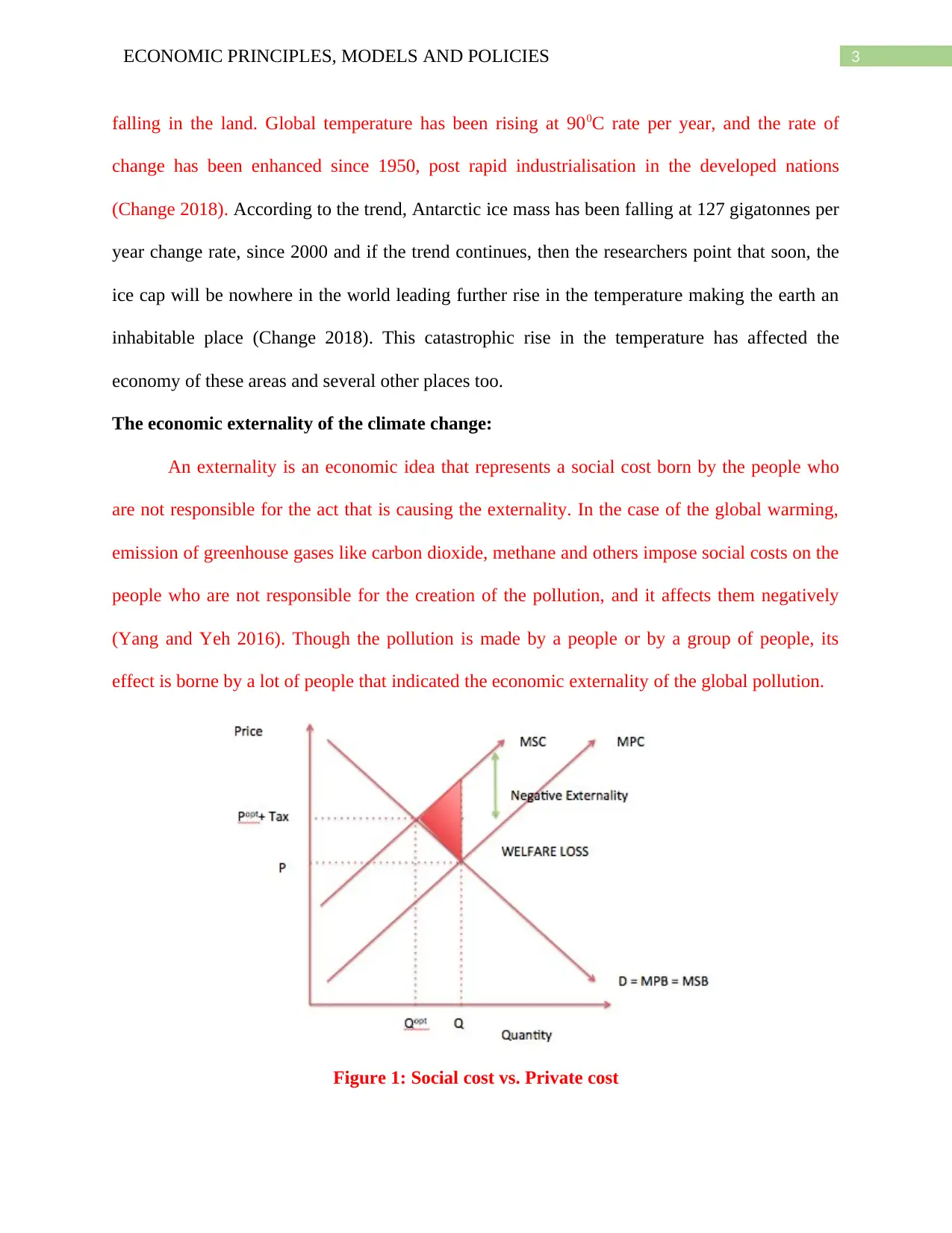
3ECONOMIC PRINCIPLES, MODELS AND POLICIES
falling in the land. Global temperature has been rising at 900C rate per year, and the rate of
change has been enhanced since 1950, post rapid industrialisation in the developed nations
(Change 2018). According to the trend, Antarctic ice mass has been falling at 127 gigatonnes per
year change rate, since 2000 and if the trend continues, then the researchers point that soon, the
ice cap will be nowhere in the world leading further rise in the temperature making the earth an
inhabitable place (Change 2018). This catastrophic rise in the temperature has affected the
economy of these areas and several other places too.
The economic externality of the climate change:
An externality is an economic idea that represents a social cost born by the people who
are not responsible for the act that is causing the externality. In the case of the global warming,
emission of greenhouse gases like carbon dioxide, methane and others impose social costs on the
people who are not responsible for the creation of the pollution, and it affects them negatively
(Yang and Yeh 2016). Though the pollution is made by a people or by a group of people, its
effect is borne by a lot of people that indicated the economic externality of the global pollution.
Figure 1: Social cost vs. Private cost
falling in the land. Global temperature has been rising at 900C rate per year, and the rate of
change has been enhanced since 1950, post rapid industrialisation in the developed nations
(Change 2018). According to the trend, Antarctic ice mass has been falling at 127 gigatonnes per
year change rate, since 2000 and if the trend continues, then the researchers point that soon, the
ice cap will be nowhere in the world leading further rise in the temperature making the earth an
inhabitable place (Change 2018). This catastrophic rise in the temperature has affected the
economy of these areas and several other places too.
The economic externality of the climate change:
An externality is an economic idea that represents a social cost born by the people who
are not responsible for the act that is causing the externality. In the case of the global warming,
emission of greenhouse gases like carbon dioxide, methane and others impose social costs on the
people who are not responsible for the creation of the pollution, and it affects them negatively
(Yang and Yeh 2016). Though the pollution is made by a people or by a group of people, its
effect is borne by a lot of people that indicated the economic externality of the global pollution.
Figure 1: Social cost vs. Private cost
Paraphrase This Document
Need a fresh take? Get an instant paraphrase of this document with our AI Paraphraser
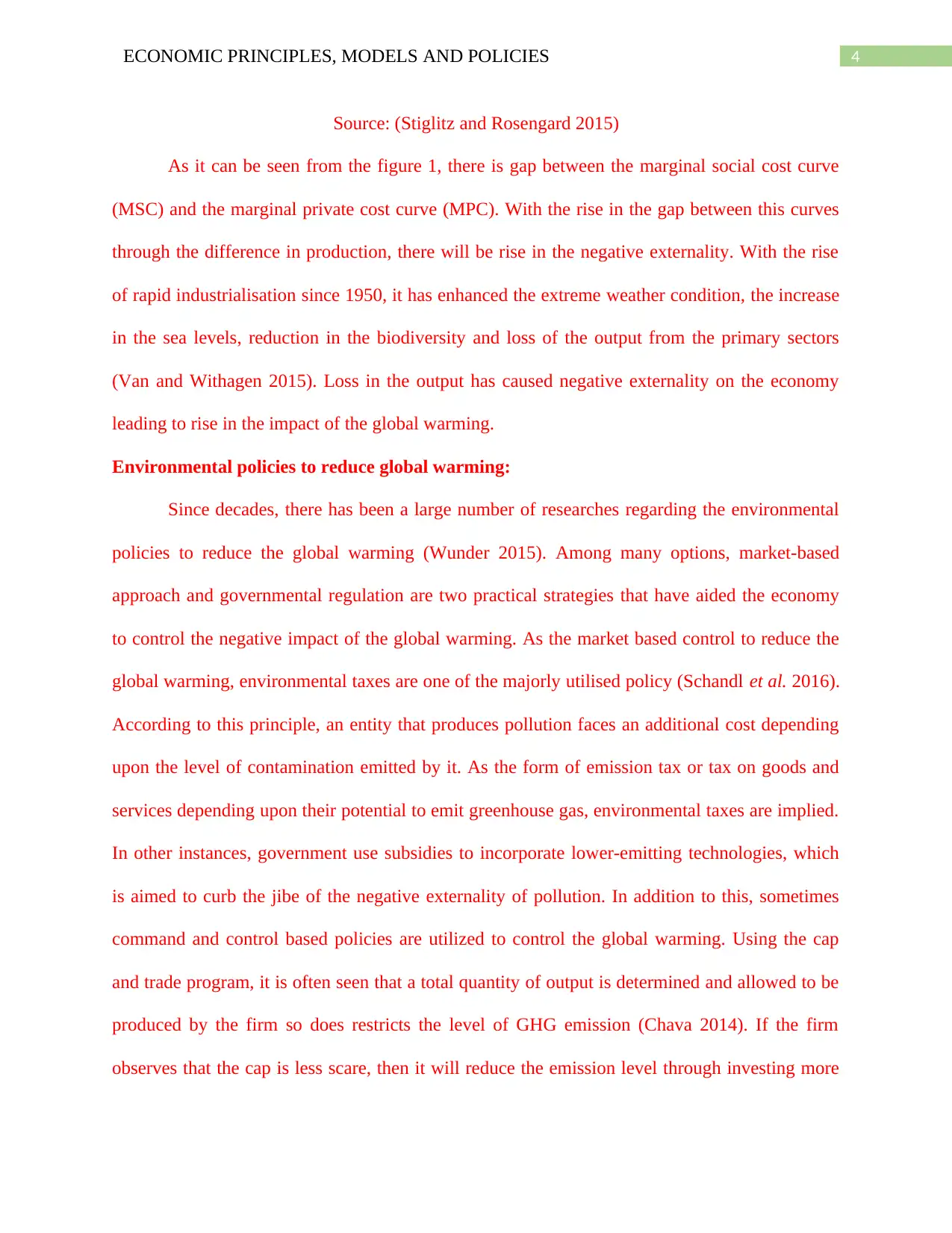
4ECONOMIC PRINCIPLES, MODELS AND POLICIES
Source: (Stiglitz and Rosengard 2015)
As it can be seen from the figure 1, there is gap between the marginal social cost curve
(MSC) and the marginal private cost curve (MPC). With the rise in the gap between this curves
through the difference in production, there will be rise in the negative externality. With the rise
of rapid industrialisation since 1950, it has enhanced the extreme weather condition, the increase
in the sea levels, reduction in the biodiversity and loss of the output from the primary sectors
(Van and Withagen 2015). Loss in the output has caused negative externality on the economy
leading to rise in the impact of the global warming.
Environmental policies to reduce global warming:
Since decades, there has been a large number of researches regarding the environmental
policies to reduce the global warming (Wunder 2015). Among many options, market-based
approach and governmental regulation are two practical strategies that have aided the economy
to control the negative impact of the global warming. As the market based control to reduce the
global warming, environmental taxes are one of the majorly utilised policy (Schandl et al. 2016).
According to this principle, an entity that produces pollution faces an additional cost depending
upon the level of contamination emitted by it. As the form of emission tax or tax on goods and
services depending upon their potential to emit greenhouse gas, environmental taxes are implied.
In other instances, government use subsidies to incorporate lower-emitting technologies, which
is aimed to curb the jibe of the negative externality of pollution. In addition to this, sometimes
command and control based policies are utilized to control the global warming. Using the cap
and trade program, it is often seen that a total quantity of output is determined and allowed to be
produced by the firm so does restricts the level of GHG emission (Chava 2014). If the firm
observes that the cap is less scare, then it will reduce the emission level through investing more
Source: (Stiglitz and Rosengard 2015)
As it can be seen from the figure 1, there is gap between the marginal social cost curve
(MSC) and the marginal private cost curve (MPC). With the rise in the gap between this curves
through the difference in production, there will be rise in the negative externality. With the rise
of rapid industrialisation since 1950, it has enhanced the extreme weather condition, the increase
in the sea levels, reduction in the biodiversity and loss of the output from the primary sectors
(Van and Withagen 2015). Loss in the output has caused negative externality on the economy
leading to rise in the impact of the global warming.
Environmental policies to reduce global warming:
Since decades, there has been a large number of researches regarding the environmental
policies to reduce the global warming (Wunder 2015). Among many options, market-based
approach and governmental regulation are two practical strategies that have aided the economy
to control the negative impact of the global warming. As the market based control to reduce the
global warming, environmental taxes are one of the majorly utilised policy (Schandl et al. 2016).
According to this principle, an entity that produces pollution faces an additional cost depending
upon the level of contamination emitted by it. As the form of emission tax or tax on goods and
services depending upon their potential to emit greenhouse gas, environmental taxes are implied.
In other instances, government use subsidies to incorporate lower-emitting technologies, which
is aimed to curb the jibe of the negative externality of pollution. In addition to this, sometimes
command and control based policies are utilized to control the global warming. Using the cap
and trade program, it is often seen that a total quantity of output is determined and allowed to be
produced by the firm so does restricts the level of GHG emission (Chava 2014). If the firm
observes that the cap is less scare, then it will reduce the emission level through investing more
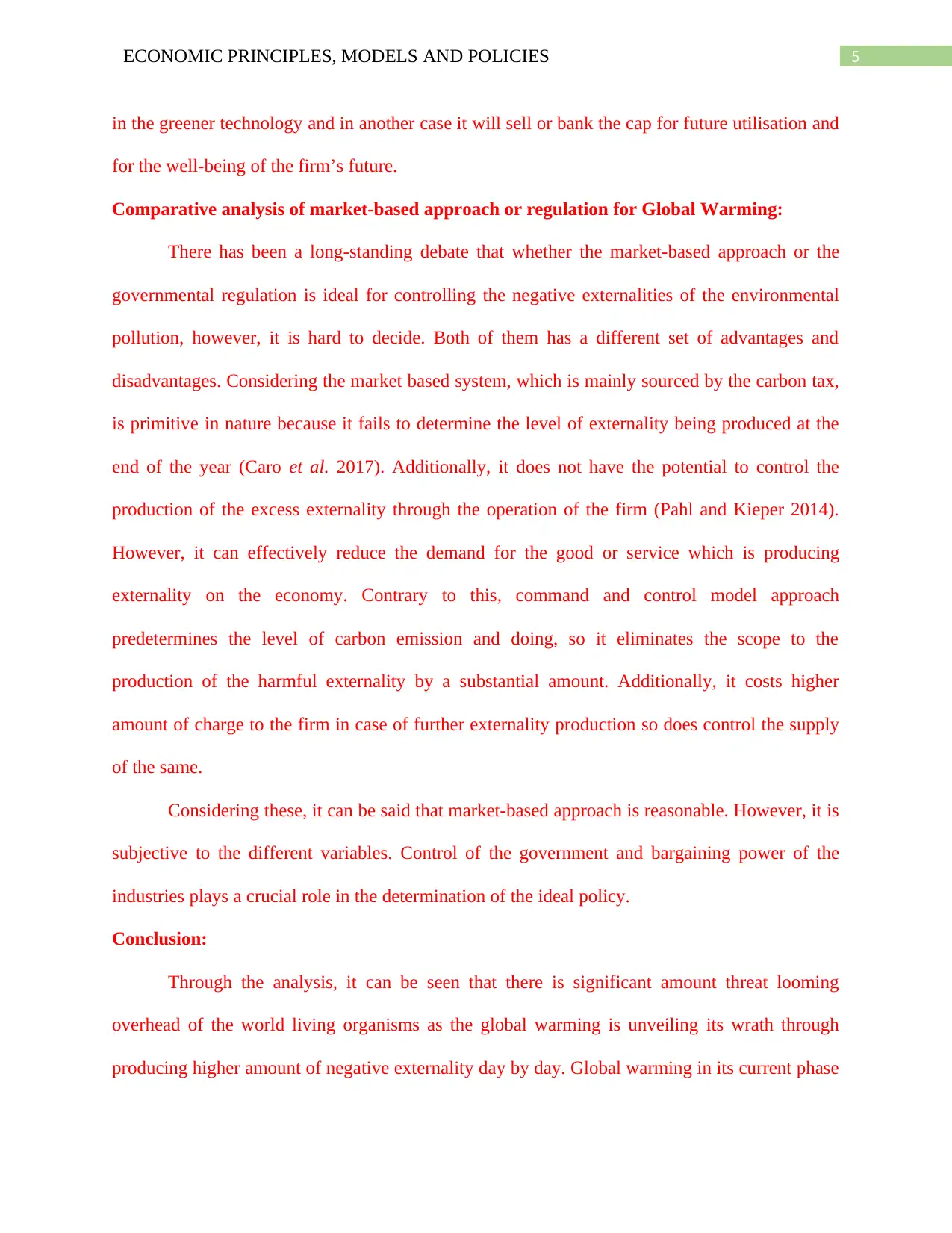
5ECONOMIC PRINCIPLES, MODELS AND POLICIES
in the greener technology and in another case it will sell or bank the cap for future utilisation and
for the well-being of the firm’s future.
Comparative analysis of market-based approach or regulation for Global Warming:
There has been a long-standing debate that whether the market-based approach or the
governmental regulation is ideal for controlling the negative externalities of the environmental
pollution, however, it is hard to decide. Both of them has a different set of advantages and
disadvantages. Considering the market based system, which is mainly sourced by the carbon tax,
is primitive in nature because it fails to determine the level of externality being produced at the
end of the year (Caro et al. 2017). Additionally, it does not have the potential to control the
production of the excess externality through the operation of the firm (Pahl and Kieper 2014).
However, it can effectively reduce the demand for the good or service which is producing
externality on the economy. Contrary to this, command and control model approach
predetermines the level of carbon emission and doing, so it eliminates the scope to the
production of the harmful externality by a substantial amount. Additionally, it costs higher
amount of charge to the firm in case of further externality production so does control the supply
of the same.
Considering these, it can be said that market-based approach is reasonable. However, it is
subjective to the different variables. Control of the government and bargaining power of the
industries plays a crucial role in the determination of the ideal policy.
Conclusion:
Through the analysis, it can be seen that there is significant amount threat looming
overhead of the world living organisms as the global warming is unveiling its wrath through
producing higher amount of negative externality day by day. Global warming in its current phase
in the greener technology and in another case it will sell or bank the cap for future utilisation and
for the well-being of the firm’s future.
Comparative analysis of market-based approach or regulation for Global Warming:
There has been a long-standing debate that whether the market-based approach or the
governmental regulation is ideal for controlling the negative externalities of the environmental
pollution, however, it is hard to decide. Both of them has a different set of advantages and
disadvantages. Considering the market based system, which is mainly sourced by the carbon tax,
is primitive in nature because it fails to determine the level of externality being produced at the
end of the year (Caro et al. 2017). Additionally, it does not have the potential to control the
production of the excess externality through the operation of the firm (Pahl and Kieper 2014).
However, it can effectively reduce the demand for the good or service which is producing
externality on the economy. Contrary to this, command and control model approach
predetermines the level of carbon emission and doing, so it eliminates the scope to the
production of the harmful externality by a substantial amount. Additionally, it costs higher
amount of charge to the firm in case of further externality production so does control the supply
of the same.
Considering these, it can be said that market-based approach is reasonable. However, it is
subjective to the different variables. Control of the government and bargaining power of the
industries plays a crucial role in the determination of the ideal policy.
Conclusion:
Through the analysis, it can be seen that there is significant amount threat looming
overhead of the world living organisms as the global warming is unveiling its wrath through
producing higher amount of negative externality day by day. Global warming in its current phase
⊘ This is a preview!⊘
Do you want full access?
Subscribe today to unlock all pages.

Trusted by 1+ million students worldwide
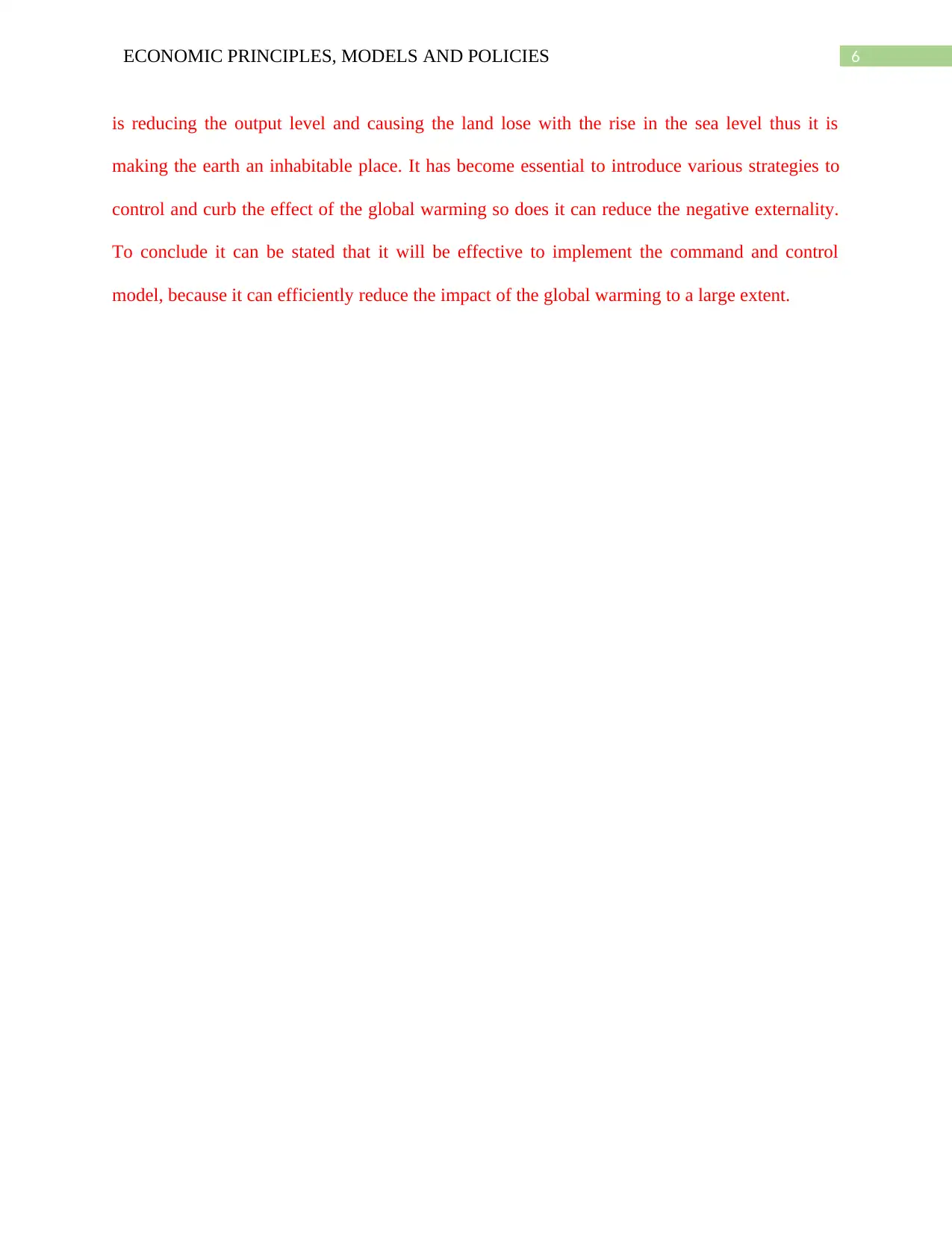
6ECONOMIC PRINCIPLES, MODELS AND POLICIES
is reducing the output level and causing the land lose with the rise in the sea level thus it is
making the earth an inhabitable place. It has become essential to introduce various strategies to
control and curb the effect of the global warming so does it can reduce the negative externality.
To conclude it can be stated that it will be effective to implement the command and control
model, because it can efficiently reduce the impact of the global warming to a large extent.
is reducing the output level and causing the land lose with the rise in the sea level thus it is
making the earth an inhabitable place. It has become essential to introduce various strategies to
control and curb the effect of the global warming so does it can reduce the negative externality.
To conclude it can be stated that it will be effective to implement the command and control
model, because it can efficiently reduce the impact of the global warming to a large extent.
Paraphrase This Document
Need a fresh take? Get an instant paraphrase of this document with our AI Paraphraser
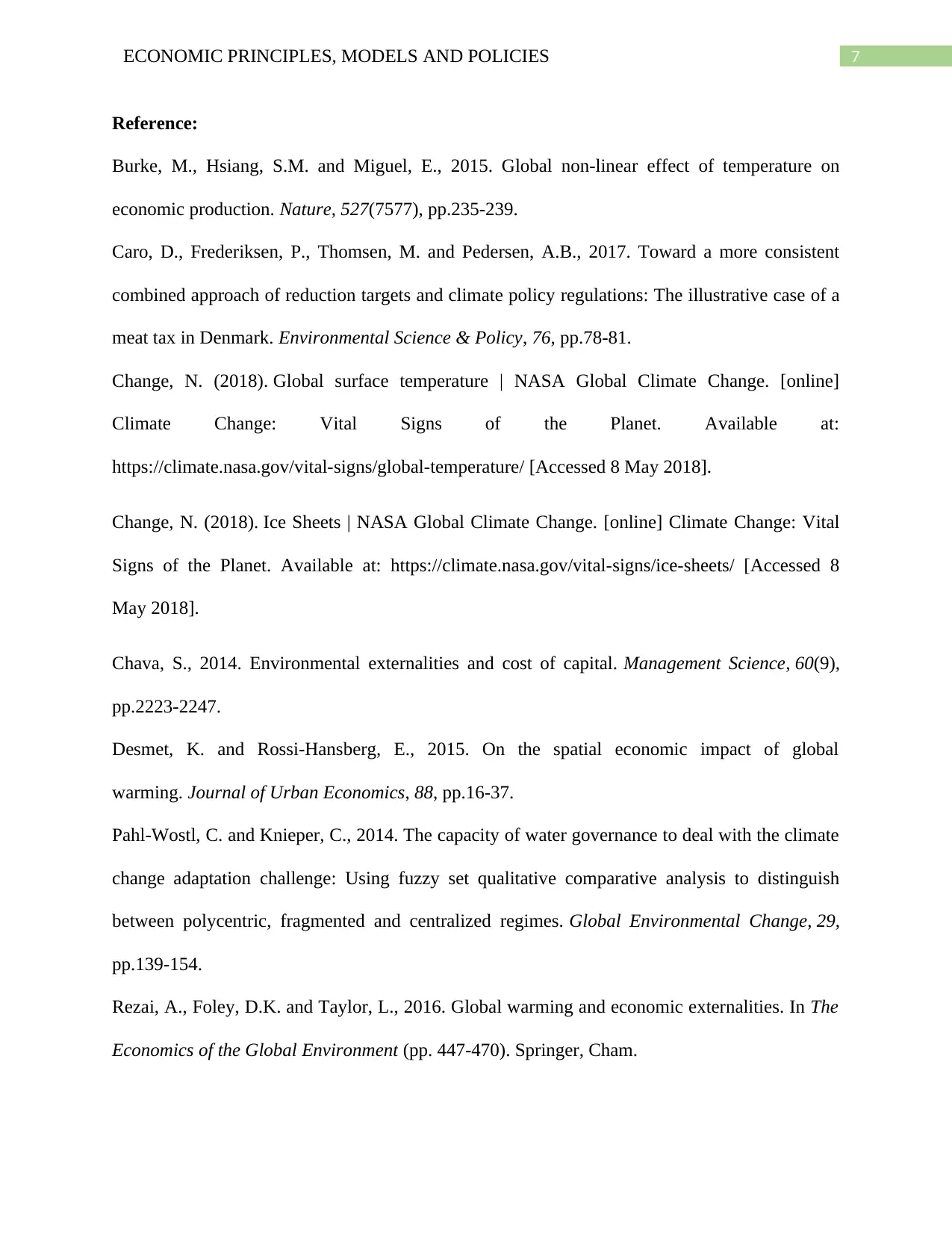
7ECONOMIC PRINCIPLES, MODELS AND POLICIES
Reference:
Burke, M., Hsiang, S.M. and Miguel, E., 2015. Global non-linear effect of temperature on
economic production. Nature, 527(7577), pp.235-239.
Caro, D., Frederiksen, P., Thomsen, M. and Pedersen, A.B., 2017. Toward a more consistent
combined approach of reduction targets and climate policy regulations: The illustrative case of a
meat tax in Denmark. Environmental Science & Policy, 76, pp.78-81.
Change, N. (2018). Global surface temperature | NASA Global Climate Change. [online]
Climate Change: Vital Signs of the Planet. Available at:
https://climate.nasa.gov/vital-signs/global-temperature/ [Accessed 8 May 2018].
Change, N. (2018). Ice Sheets | NASA Global Climate Change. [online] Climate Change: Vital
Signs of the Planet. Available at: https://climate.nasa.gov/vital-signs/ice-sheets/ [Accessed 8
May 2018].
Chava, S., 2014. Environmental externalities and cost of capital. Management Science, 60(9),
pp.2223-2247.
Desmet, K. and Rossi-Hansberg, E., 2015. On the spatial economic impact of global
warming. Journal of Urban Economics, 88, pp.16-37.
Pahl-Wostl, C. and Knieper, C., 2014. The capacity of water governance to deal with the climate
change adaptation challenge: Using fuzzy set qualitative comparative analysis to distinguish
between polycentric, fragmented and centralized regimes. Global Environmental Change, 29,
pp.139-154.
Rezai, A., Foley, D.K. and Taylor, L., 2016. Global warming and economic externalities. In The
Economics of the Global Environment (pp. 447-470). Springer, Cham.
Reference:
Burke, M., Hsiang, S.M. and Miguel, E., 2015. Global non-linear effect of temperature on
economic production. Nature, 527(7577), pp.235-239.
Caro, D., Frederiksen, P., Thomsen, M. and Pedersen, A.B., 2017. Toward a more consistent
combined approach of reduction targets and climate policy regulations: The illustrative case of a
meat tax in Denmark. Environmental Science & Policy, 76, pp.78-81.
Change, N. (2018). Global surface temperature | NASA Global Climate Change. [online]
Climate Change: Vital Signs of the Planet. Available at:
https://climate.nasa.gov/vital-signs/global-temperature/ [Accessed 8 May 2018].
Change, N. (2018). Ice Sheets | NASA Global Climate Change. [online] Climate Change: Vital
Signs of the Planet. Available at: https://climate.nasa.gov/vital-signs/ice-sheets/ [Accessed 8
May 2018].
Chava, S., 2014. Environmental externalities and cost of capital. Management Science, 60(9),
pp.2223-2247.
Desmet, K. and Rossi-Hansberg, E., 2015. On the spatial economic impact of global
warming. Journal of Urban Economics, 88, pp.16-37.
Pahl-Wostl, C. and Knieper, C., 2014. The capacity of water governance to deal with the climate
change adaptation challenge: Using fuzzy set qualitative comparative analysis to distinguish
between polycentric, fragmented and centralized regimes. Global Environmental Change, 29,
pp.139-154.
Rezai, A., Foley, D.K. and Taylor, L., 2016. Global warming and economic externalities. In The
Economics of the Global Environment (pp. 447-470). Springer, Cham.
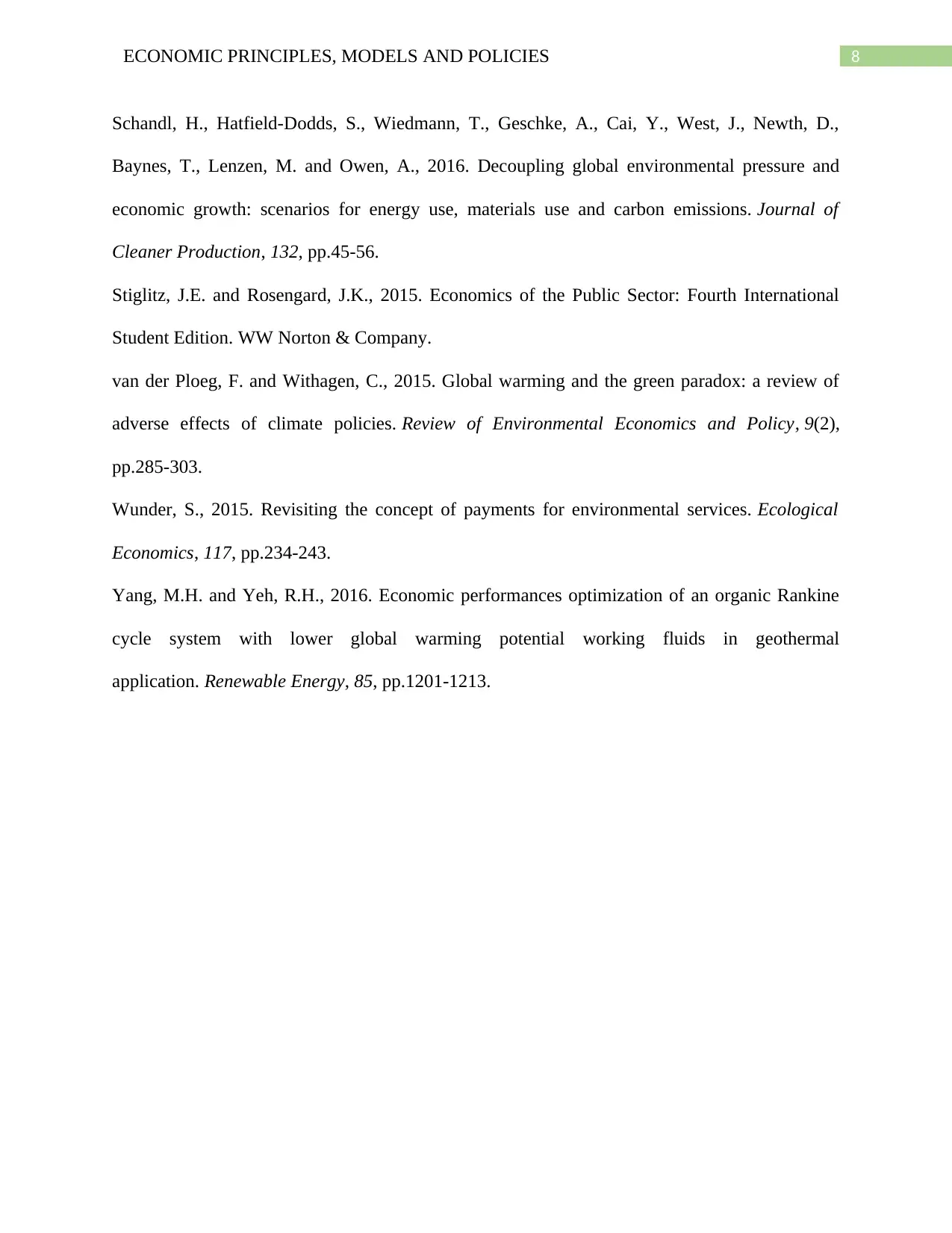
8ECONOMIC PRINCIPLES, MODELS AND POLICIES
Schandl, H., Hatfield-Dodds, S., Wiedmann, T., Geschke, A., Cai, Y., West, J., Newth, D.,
Baynes, T., Lenzen, M. and Owen, A., 2016. Decoupling global environmental pressure and
economic growth: scenarios for energy use, materials use and carbon emissions. Journal of
Cleaner Production, 132, pp.45-56.
Stiglitz, J.E. and Rosengard, J.K., 2015. Economics of the Public Sector: Fourth International
Student Edition. WW Norton & Company.
van der Ploeg, F. and Withagen, C., 2015. Global warming and the green paradox: a review of
adverse effects of climate policies. Review of Environmental Economics and Policy, 9(2),
pp.285-303.
Wunder, S., 2015. Revisiting the concept of payments for environmental services. Ecological
Economics, 117, pp.234-243.
Yang, M.H. and Yeh, R.H., 2016. Economic performances optimization of an organic Rankine
cycle system with lower global warming potential working fluids in geothermal
application. Renewable Energy, 85, pp.1201-1213.
Schandl, H., Hatfield-Dodds, S., Wiedmann, T., Geschke, A., Cai, Y., West, J., Newth, D.,
Baynes, T., Lenzen, M. and Owen, A., 2016. Decoupling global environmental pressure and
economic growth: scenarios for energy use, materials use and carbon emissions. Journal of
Cleaner Production, 132, pp.45-56.
Stiglitz, J.E. and Rosengard, J.K., 2015. Economics of the Public Sector: Fourth International
Student Edition. WW Norton & Company.
van der Ploeg, F. and Withagen, C., 2015. Global warming and the green paradox: a review of
adverse effects of climate policies. Review of Environmental Economics and Policy, 9(2),
pp.285-303.
Wunder, S., 2015. Revisiting the concept of payments for environmental services. Ecological
Economics, 117, pp.234-243.
Yang, M.H. and Yeh, R.H., 2016. Economic performances optimization of an organic Rankine
cycle system with lower global warming potential working fluids in geothermal
application. Renewable Energy, 85, pp.1201-1213.
⊘ This is a preview!⊘
Do you want full access?
Subscribe today to unlock all pages.

Trusted by 1+ million students worldwide
1 out of 9
Related Documents
Your All-in-One AI-Powered Toolkit for Academic Success.
+13062052269
info@desklib.com
Available 24*7 on WhatsApp / Email
![[object Object]](/_next/static/media/star-bottom.7253800d.svg)
Unlock your academic potential
Copyright © 2020–2025 A2Z Services. All Rights Reserved. Developed and managed by ZUCOL.





